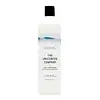What's inside
What's inside
 Key Ingredients
Key Ingredients

 Benefits
Benefits

 Concerns
Concerns

 Ingredients Side-by-side
Ingredients Side-by-side

Water
Skin ConditioningCetyl Alcohol
EmollientBehentrimonium Chloride
PreservativeStearalkonium Chloride
PreservativeStearyl Alcohol
EmollientGlycerin
HumectantCocos Nucifera Oil
MaskingPropanediol
SolventCoco-Caprylate
EmollientIsopropyl Alcohol
SolventGuar Hydroxypropyltrimonium Chloride
Skin ConditioningHydrolyzed Rice Protein
Skin ConditioningPanthenol
Skin ConditioningTocopheryl Acetate
AntioxidantCitric Acid
BufferingPhenoxyethanol
PreservativeEthylhexylglycerin
Skin ConditioningWater, Cetyl Alcohol, Behentrimonium Chloride, Stearalkonium Chloride, Stearyl Alcohol, Glycerin, Cocos Nucifera Oil, Propanediol, Coco-Caprylate, Isopropyl Alcohol, Guar Hydroxypropyltrimonium Chloride, Hydrolyzed Rice Protein, Panthenol, Tocopheryl Acetate, Citric Acid, Phenoxyethanol, Ethylhexylglycerin
Water
Skin ConditioningCetyl Alcohol
EmollientStearyl Alcohol
EmollientDimethicone
EmollientBehentrimonium Chloride
PreservativeParfum
MaskingIsopropyl Alcohol
SolventDipentaerythrityl Hexahydroxystearate/Hexastearate/Hexarosinate
Skin ConditioningAmodimethicone
Glyceryl Caprylate
EmollientEthylhexylglycerin
Skin ConditioningDisodium EDTA
Hexyl Cinnamal
PerfumingBenzyl Benzoate
AntimicrobialLinalool
PerfumingLimonene
PerfumingSteartrimonium Chloride
PreservativeButylene Glycol
HumectantCamellia Japonica Seed Oil
EmollientPunica Granatum Fruit Extract
AntioxidantLactic Acid
BufferingSodium Benzoate
MaskingTocopherol
AntioxidantAlcohol
AntimicrobialArgania Spinosa Kernel Oil
EmollientHelianthus Annuus Seed Oil
EmollientCamellia Sinensis Seed Oil
HumectantPPG-3 Caprylyl Ether
SolventGlycolipids
Skin ConditioningGlycyrrhiza Glabra Root Extract
BleachingXylitylglucoside
HumectantAnhydroxylitol
HumectantXylitol
HumectantCamellia Sinensis Leaf Extract
AntimicrobialCornus Officinalis Fruit Extract
Skin ConditioningPanax Ginseng Root Extract
EmollientZingiber Officinale Root Extract
MaskingDipropylene Glycol
HumectantNelumbo Nucifera Flower Extract
Skin ConditioningPaeonia Lactiflora Root Extract
Skin ConditioningRehmannia Glutinosa Root Extract
Skin ConditioningRoyal Jelly Extract
Skin ConditioningGlucose
HumectantHoney
HumectantLilium Candidum Bulb Extract
Skin ConditioningPhenoxyethanol
PreservativeAcetic Acid
BufferingSchisandra Chinensis Fruit Extract
Skin ConditioningTrideceth-10
CleansingPolygonatum Odoratum Rhizome Extract
Skin ConditioningWater, Cetyl Alcohol, Stearyl Alcohol, Dimethicone, Behentrimonium Chloride, Parfum, Isopropyl Alcohol, Dipentaerythrityl Hexahydroxystearate/Hexastearate/Hexarosinate, Amodimethicone, Glyceryl Caprylate, Ethylhexylglycerin, Disodium EDTA, Hexyl Cinnamal, Benzyl Benzoate, Linalool, Limonene, Steartrimonium Chloride, Butylene Glycol, Camellia Japonica Seed Oil, Punica Granatum Fruit Extract, Lactic Acid, Sodium Benzoate, Tocopherol, Alcohol, Argania Spinosa Kernel Oil, Helianthus Annuus Seed Oil, Camellia Sinensis Seed Oil, PPG-3 Caprylyl Ether, Glycolipids, Glycyrrhiza Glabra Root Extract, Xylitylglucoside, Anhydroxylitol, Xylitol, Camellia Sinensis Leaf Extract, Cornus Officinalis Fruit Extract, Panax Ginseng Root Extract, Zingiber Officinale Root Extract, Dipropylene Glycol, Nelumbo Nucifera Flower Extract, Paeonia Lactiflora Root Extract, Rehmannia Glutinosa Root Extract, Royal Jelly Extract, Glucose, Honey, Lilium Candidum Bulb Extract, Phenoxyethanol, Acetic Acid, Schisandra Chinensis Fruit Extract, Trideceth-10, Polygonatum Odoratum Rhizome Extract
 Reviews
Reviews

Ingredients Explained
These ingredients are found in both products.
Ingredients higher up in an ingredient list are typically present in a larger amount.
This ingredient is a preservative and often used for it's anti-static properties. You'll most likely see this ingredient in hair conditioners.
It does not cause irritation or sensitization in leave-on products at 1-5%.
Cetyl Alcohol is a fatty alcohol. Fatty Alcohols are most often used as an emollient or to thicken a product.
Its main roles are:
Though it has "alcohol" in the name, it is not related to denatured alcohol or ethyl alcohol.
The FDA allows products labeled "alcohol-free" to have fatty alcohols.
Learn more about Cetyl AlcoholEthylhexylglycerin (we can't pronounce this either) is commonly used as a preservative and skin softener. It is derived from glyceryl.
You might see Ethylhexylglycerin often paired with other preservatives such as phenoxyethanol. Ethylhexylglycerin has been found to increase the effectiveness of these other preservatives.
Isopropyl Alcohol is more commonly known as rubbing alcohol. It is most commonly used as a solvent, meaning it helps other ingredients dissolve.
This ingredient is an astringent alcohol. Astringent alcohols may also irritate skin as they high amounts may strip away your skin's natural oils.
Other types of astringent alcohols include:
According to the National Rosacea Society based in the US, you should be mindful of products with these alcohols in the top half of ingredients.
Any type of sanitizing product will have high amounts of alcohol to help kill bacteria and viruses.
Learn more about Isopropyl AlcoholPhenoxyethanol is a preservative that has germicide, antimicrobial, and aromatic properties. Studies show that phenoxyethanol can prevent microbial growth. By itself, it has a scent that is similar to that of a rose.
It's often used in formulations along with Caprylyl Glycol to preserve the shelf life of products.
Stearyl Alcohol is a type of fatty alcohol from stearic acid. It is a white, waxy compound used to emulsify ingredients.
Fatty Alcohols are most often used as an emollient or to thicken a product. Emollients help soothe and hydrate the skin by trapping moisture.
They are usually derived from natural fats and oils and therefore do not have the same drying or irritating effect as solvent alcohols. FDA allows products labeled "alcohol-free" to have fatty alcohols.
Learn more about Stearyl AlcoholWater. It's the most common cosmetic ingredient of all. You'll usually see it at the top of ingredient lists, meaning that it makes up the largest part of the product.
So why is it so popular? Water most often acts as a solvent - this means that it helps dissolve other ingredients into the formulation.
You'll also recognize water as that liquid we all need to stay alive. If you see this, drink a glass of water. Stay hydrated!
Learn more about Water